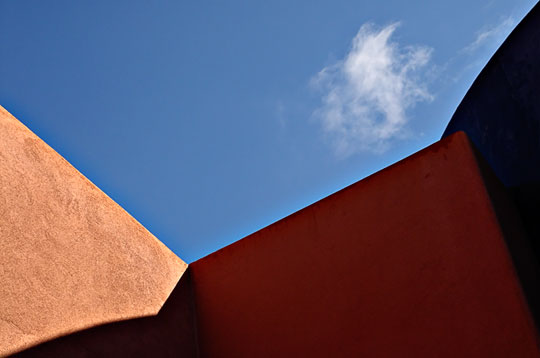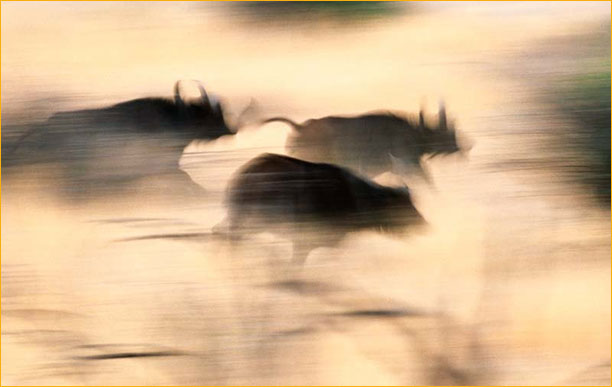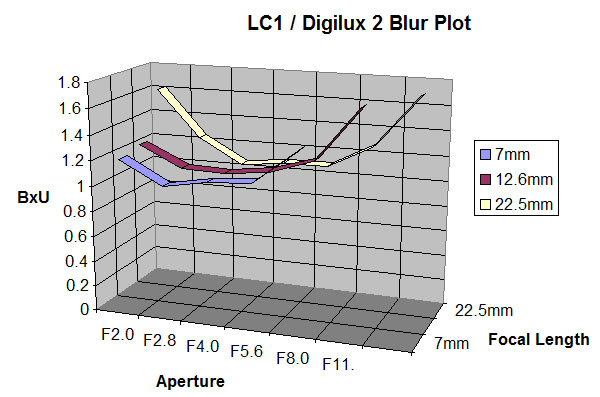
I’ve always had a pocket camera. I don’t carry it all the time — not much happens on the way to the milk store — but when I go anywhere that I think might have picture possibilities I bring along a camera. Since I don’t want to look like a total dork I usually don’t bring along a bulky SLR, so a pocket camera is often in my pocket instead. I also use a pocket cameras as a sort of visual note pad, photographing places or concepts that I think might want to return to or explore in greater detail.
In the film days I had cameras like the wonderful but now historicRollei 35SE, and more recently theRicoh GR1s. I wrote about these in an essay a couple of years ago titled, curiously enough,Two Pocket 35mm Cameras. I’ve had a couple of small digicams since then, most recently the very nice but chubbyCanon S50, but I’ve been waiting for something that truly is small enough to fit in even a shirt pocket, yet is able to produce high quality 8X10" prints.
Sony DSC-T1 @ ISO 100
The Wait is Over
TheSony T1just became available outside of Japan early in the new year, and already it is regarded as thecoolestnew camera on the block. But as everyone except teenagers knows, beingcoolisn’t enough. A camera needs to deliver the goods, and I’m pleased to say that this the T1 does.
Weighing in at just 200g (7.1oz) the T1 is about the size of a credit card, though obviously a bit thicker. It features a 6.7 — 20.1mm, f/3.5-f/4.4 lens (38-114mm equivalent). This 3X zoomZeiss Vario-Tessarlens is buried completely within the body of the T1, in a design similar to Minolta’s X series pocket cameras. A prism is used to deflect the image downward into the lens which physically changes focal length inside the camera body.
The lens is covered by a vertically sliding door with also turns the camera on and off. In typical Sony fashion (meant both ways), the T1 is elegantly styled, beautifully finished, and uses first rate materials.
The big news is that this is a 5 Megapixel camera. That means it can produce 8X10" prints (at 240ppi) without any ressing up. It also features a very large (2.5") LCD that fills more than two thirds of the rear of the camera. This is a first-rate screen — viewable even in the brightest sunlight — and it better be — because the T1 doesn’t have an optical viewfinder. The LCD isit. This takes some getting used to, and the fact that it doesn’t swivel means that sometimes positioning the camera for a shot can be a bit awkward. But the compromise is worthwhile because of the camera’s small size.
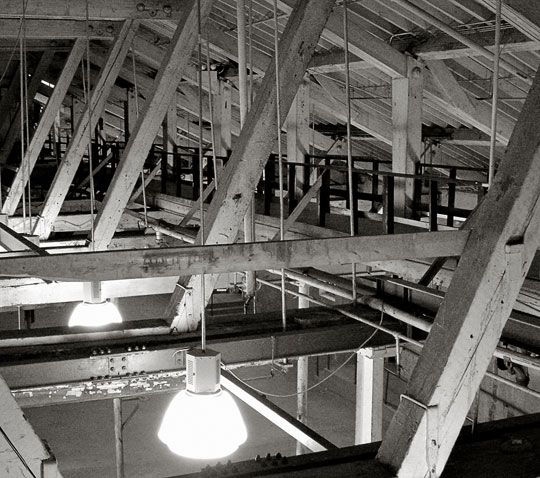
In the Rafters — Toronto. February, 2004
Sony T1 @ ISO 400. 6.7mm (35mm Equiv). Cropped 50%
The menu system is modeled on the layout of theSony F828, and that’s no bad thing. Settings are simple and intuitive.
Almost all of the features of larger digicams are found on the T1. This includes a built-in flash, close-up modes, audio recording, self timer, variable ISO settings from 100-400, exposure compensation, instant review, live histogram!, and image review magnification. There is even a 640X480 30fps MPEG movie mode!
Be aware though that other than some "scene" type modes the camera only has Program mode. No Aperture or Shutter Priority, or Manual modes. I don’t see this as a big deal because one typically uses a camera like this as a point-and-shoot.
The camera comes with the typical universal voltage power adaptor / charger, and also a small docking cradle. The cradle has ports for USB2 as well as video and audio output. The power supply plugs into the cradle, but can also plug directly into the camera for when traveling.
The Gripes
If it sounds like I’m impressed, it’s because I am. But, all is not perfect, and there are a few gripes. Battery life appears to be very good, using theSony InfoLithiumsystem that keeps you informed of the exact state of the battery’s condition. But the battery can be inserted backwards, something that surprised me, because Sony is one of the better companies when it comes to sweating such details.
The battery and theMemorystick Duocard slot share the same compartment, and so when you open the door to remove the card the battery can fall out if you’re not careful. I’m also not a big fan of Sony’s overpriced and too smallMemorystick Duocards. They do provide an adaptor to full-size Memorystick along with the supplied 32MB card. This card doesn’t have enough capacity, so figure that you’ll have to buy at least a 256MB card at about another $100 to handle a day’s shooting.
Image Quality
Subjectively image quality is first rate. I made a ressed-up 13X19" print of the photograph below, and it could easily be mistaken as having been shot with a 6 Megapixel DSLR.

Flasher — Toronto. February, 2004
Sony T1 @ ISO 100. 10mm (55mm Equiv)
DxO Analyzer Test Results
An Optical Analysis
Using

This test of theSony DSC-T1camera and lens was conducted usingDxO Analyzer. If you are not familiar with this optical testing system please readthis tutorial. Without being familiar with how the tests are conducted, and how to read them, there’s not much point in proceeding.
The purpose of this test report is to support the empirical findings of my field test of this system. Though the tests on this page are interesting and informative (as well as accurate and repeatable), they really only tell us about selected aspects of a camera or lens’ capabilities.
About The Tests
As you can see from theDxO Tutorialthere are a large number of charts and text graphs produced for each of the four tests —Distortion & Chromatic Aberration,Vignetting,NoiseandBlur. A more comprehensive test would have to be done at all available apertures, all available ISO speeds, and at a large cross-section of focal lengths (in the case of zoom lenses). This would not only take an inordinately large amount of time to conduct, but would take up far to much space here and likely not be of much interest.
Consequently in this and other tests usingDxO AnalyzerI am publishing just one complete set of charts — those done at f/5.6, which is typically an optimum aperture for most lenses. In the case of zoom lenses this test is also done at a mid-position in the lens’ focal length range. I also post data for other F stops, ISO ratings and in the case of zooms a selection of focal length, including the widest and longest. In my comments to each section I also draw attention to extremes of performance, such as maximum vignetting, greatest and least noise, etc.
To jump directly to the definition and tutorial for a specific test click on theDC,V,NorBlogos.
Distortion and Chromatic Aberration
Sony DSC-T1 @ ISO 64.
Focal Length = 10.1mm (55mm equivalent)


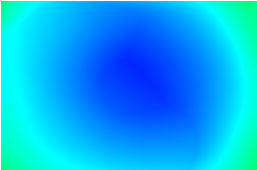



Observation
Barrel distortion at 10mm (55mm Equiv) is moderate, but shouldn’t be an issue for this camera’s typical usage.
Chromatic aberration is high, though better than the Sony F828 at the wide wide end of its zoom range, and less than the F828 at the long end, at the same aperture. In field tests I’ve noticed no significant blooming, and what CA there is to be measured isn’t readily visible in prints.
Vignetting
t
Observation
Vignetting is moderately high, at about three quarters of a stop. Not unusual for small digital lenses.
Noise
Observation
When I first looked at the S/N results at ISO 100, I thought — typical of a camera like this. OK, but not great. Then I looked at the results for ISO 200 and 400, which are not much different. I thought I’d made a mistake, so I went back and redid the tests. Same results.
So I did some test field tests designed to show what noise there might be, particularly in smooth and dark areas of the frame, where it would be most visible. The shot below was taken at ISO 400.
Full Frame @ ISO 400
Crop at Actual PixelsI’m impressed by the low noise, not to mention the detail. This degree of enlargement is equal to an on-screen image size of 3 feet in width. This is as good as if not better than the best ISO 400 colour negative films in terms of grain.
Blur
This plot is not directly comparable to those for other cameras
as the camera offers no control over aperture selection. This therefore
simply shows the increase in subjective blur as focal length increases.
The lens is obviously somewhat sharper at wider focal lengths.Observation
Not great numbers, but respectable for a pocket camera, though the edges do tend to get quite a bit softer than the center. I found that the camera produced sharper images than the blur test would have predicted. (This is why subjective field tests and optical tests need to be done together. Neither alone tells the full story).
The Bottom Line
The Sony T1 is an admirable little camera. This image size and quality from a credit card-sized digital camera was undreamed of just a few years ago. Is the T1 better than others in its price and size class? I have no idea. But at the rate of change happening in digicams at the moment any lead that it might have will likely be short-lived. In the meantime this is a very sweet little camera that any serious photographer would be pleased to own and shoot with. It definitely pleased me, and so a Sony T1 has taken up a permanent home inmypocket. Retail price is approximate U.S. $550 as of March, 2004.
Want another opinion?
You May Also Enjoy...
Ricoh GXR Mount A12
By Sean Reid of Reid Reviews Michael has asked me to share some initial impressions of Ricoh's new Mount A12 unit for their GXR system. What
Women in Photography: Luminous Endowment Winners
I make a point of looking over each group of Luminous Endowment winners when they are announced, taking some time with the pictures, maybe doing
